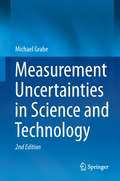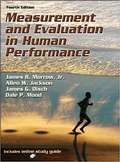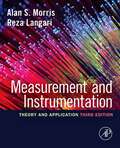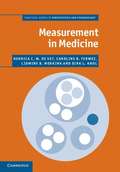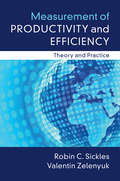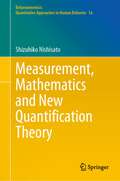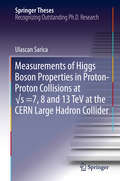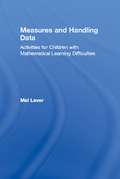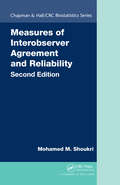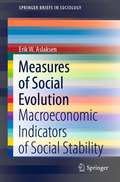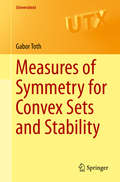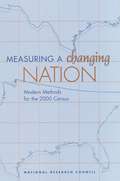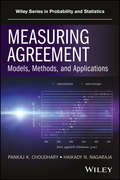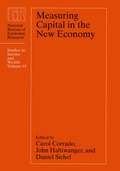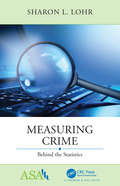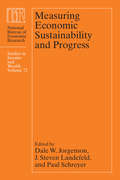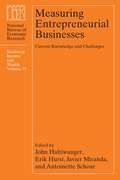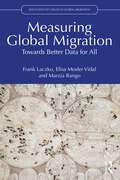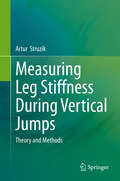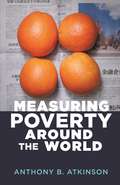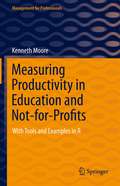- Table View
- List View
Measurement Uncertainties in Science and Technology
by Michael GrabeThis book recasts the classical Gaussian error calculus from scratch, the inducements concerning both random and unknown systematic errors. The idea of this book is to create a formalism being fit to localize the true values of physical quantities considered - true with respect to the set of predefined physical units. Remarkably enough, the prevailingly practiced forms of error calculus do not feature this property which however proves in every respect, to be physically indispensable. The amended formalism, termed Generalized Gaussian Error Calculus by the author, treats unknown systematic errors as biases and brings random errors to bear via enhanced confidence intervals as laid down by Student. The significantly extended second edition thoroughly restructures and systematizes the text as a whole and illustrates the formalism by numerous numerical examples. They demonstrate the basic principles of how to understand uncertainties to localize the true values of measured values - a perspective decisive in view of the contested physical explorations.
Measurement Uncertainty and Probability
by Robin WillinkA measurement result is incomplete without a statement of its 'uncertainty' or 'margin of error'. But what does this statement actually tell us? By examining the practical meaning of probability, this book discusses what is meant by a '95 percent interval of measurement uncertainty', and how such an interval can be calculated. The book argues that the concept of an unknown 'target value' is essential if probability is to be used as a tool for evaluating measurement uncertainty. It uses statistical concepts, such as a conditional confidence interval, to present 'extended' classical methods for evaluating measurement uncertainty. The use of the Monte Carlo principle for the simulation of experiments is described. Useful for researchers and graduate students, the book also discusses other philosophies relating to the evaluation of measurement uncertainty. It employs clear notation and language to avoid the confusion that exists in this controversial field of science.
Measurement and Evaluation in Human Performance
by Jr. Dale P. Mood James R. Morrow Allen W. Jackson James G. DischMeasurement and Evaluation in Human Performance, Fourth Edition, paves the way for students and professionals to identify and solve human performance problems in the areas of kinesiology, physical education, health, and fitness. Focusing on the concepts of reliability, objectivity, and validity, the text introduces students to tests and measurements and guides them through statistical decision making and accurate interpretation of data. Measurement and Evaluation in Human Performance, Fourth Edition, is designed with student learning in mind with its practical approach, easy-to-read style, and minimal mathematics. Like previous editions, the text combines introductory algebraic concepts with explanations of reliability and validity to assist students in developing the knowledge and tools to gather and analyze data for decision making. The fourth edition also features many upgrades: • An updated online study guide that incorporates more student activities, computer tasks, and quiz questions to help students comprehend the concepts • A realignment of chapters into four cohesive sections leading from background knowledge and basic statistical concepts to supportive theories and practical application • Greater use of Microsoft Excel to assist with statistical calculations, including an appendix of directions, screen captures, and templates for complex calculations • Inclusion of large sample data sets with each chapter’s online study guide content that help students review concepts and emphasize the value of computer skills in the field of measurement and evaluation • More information on physical activity assessment incorporated into all chapters • A new contributor who lends expertise to teachers and coaches in a chapter addressing performance-based assessment In addition to incorporating use of MS Excel, this edition continues to use Predictive Analysis Software (PASW), previously known as Statistical Package for the Social Sciences (SPSS). These computer applications provide students with the skills to quickly complete time-consuming and difficult calculations for large amounts of data.
Measurement and Probability
by Giovanni Battista RossiMeasurement plays a fundamental role both in physical and behavioral sciences, as well as in engineering and technology: it is the link between abstract models and empirical reality and is a privileged method of gathering information from the real world. Is it possible to develop a single theory of measurement for the various domains of science and technology in which measurement is involved? This book takes the challenge by addressing the following main issues: What is the meaning of measurement? How do we measure? What can be measured? A theoretical framework that could truly be shared by scientists in different fields, ranging from physics and engineering to psychology is developed. The future in fact will require greater collaboration between science and technology and between different sciences. Measurement, which played a key role in the birth of modern science, can act as an essential interdisciplinary tool and language for this new scenario. A sound theoretical basis for addressing key problems in measurement is provided. These include perceptual measurement, the evaluation of uncertainty, the evaluation of inter-comparisons, the analysis of risks in decision-making and the characterization of dynamical measurement. Currently, increasing attention is paid to these issues due to their scientific, technical, economic and social impact. The book proposes a unified probabilistic approach to them which may allow more rational and effective solutions to be reached. Great care was taken to make the text as accessible as possible in several ways. Firstly, by giving preference to as interdisciplinary a terminology as possible; secondly, by carefully defining and discussing all key terms. This ensures that a wide readership, including people from different mathematical backgrounds and different understandings of measurement can all benefit from this work. Concerning mathematics, all the main results are preceded by intuitive discussions and illustrated by simple examples. Moreover, precise proofs are always included in order to enable the more demanding readers to make conscious and creative use of these ideas, and also to develop new ones. The book demonstrates that measurement, which is commonly understood to be a merely experimental matter, poses theoretical questions which are no less challenging than those arising in other, apparently more theoretical, disciplines.
Measurement in Medicine
by Dirk L. Knol Henrica C. de Vet Caroline B. Terwee Lidwine B. MokkinkThe success of the Apgar score demonstrates the astounding power of an appropriate clinical instrument. This down-to-earth book provides practical advice, underpinned by theoretical principles, on developing and evaluating measurement instruments in all fields of medicine. It equips you to choose the most appropriate instrument for specific purposes. The book covers measurement theories, methods and criteria for evaluating and selecting instruments. It provides methods to assess measurement properties, such as reliability, validity and responsiveness, and interpret the results. Worked examples and end-of-chapter assignments use real data and well-known instruments to build your skills at implementation and interpretation through hands-on analysis of real-life cases. All data and solutions are available online. This is a perfect course book for students and a perfect companion for professionals/researchers in the medical and health sciences who care about the quality and meaning of the measurements they perform.
Measurement of Higgs Boson Production Cross Sections in the Diphoton Channel: with the full ATLAS Run-2 Data and Constraints on Anomalous Higgs Boson Interactions (Springer Theses)
by Ahmed Tarek Abouelfadl MohamedThis thesis presents the measurement of the Higgs boson cross section in the diphoton decay channel. The measurement relies on proton-proton collision data at a center-of-mass energy √s = 13 TeV recorded by the ATLAS experiment at the Large Hadron Collider (LHC). The collected data correspond to the full Run-2 dataset with an integrated luminosity of 139 fb-1. The measured cross sections are used to constrain anomalous Higgs boson interactions in the Effective Field Theory (EFT) framework. The results presented in this thesis represent a reduction by a factor 2 of the different photon and jet energy scale and resolution systematic uncertainties with respect to the previous ATLAS publication. The thesis details the calibration of electron and photon energies in ATLAS, in particular the measurement of the presampler energy scale and the estimation of its systematic uncertainty. This calibration was used to perform a measurement of the Higgs boson mass in the H → γγ and H → 4l channels using the 36 fb−1 dataset.
Measurement of Productivity and Efficiency: Theory and Practice
by Professor Robin C. Sickles Professor Valentin ZelenyukMethods and perspectives to model and measure productivity and efficiency have made a number of important advances in the last decade. Using the standard and innovative formulations of the theory and practice of efficiency and productivity measurement, Robin C. Sickles and Valentin Zelenyuk provide a comprehensive approach to productivity and efficiency analysis, covering its theoretical underpinnings and its empirical implementation, paying particular attention to the implications of neoclassical economic theory. A distinct feature of the book is that it presents a wide array of theoretical and empirical methods utilized by researchers and practitioners who study productivity issues. An accompanying website includes methods, programming codes that can be used with widely available software like Matlab, R, and Julia, and test data for many of the productivity and efficiency estimators discussed in the book. It will be valuable to upper-level undergraduates, graduate students, and professionals.
Measurement, Mathematics and New Quantification Theory (Behaviormetrics: Quantitative Approaches to Human Behavior #16)
by Shizuhiko NishisatoThe purpose of this book is to thoroughly prepare diverse areas of researchers in quantification theory. As is well known, quantification theory has attracted the attention of a countless number of researchers, some mathematically oriented and others not, but all of them are experts in their own disciplines. Quantifying non-quantitative (qualitative) data requires a variety of mathematical and statistical strategies, some of which are quite complicated. Unlike many books on quantification theory, the current book places more emphasis on preliminary requisites of mathematical tools than on details of quantification theory. As such, the book is primarily intended for readers whose specialty is outside mathematical sciences. The book was designed to offer non-mathematicians a variety of mathematical tools used in quantification theory in simple terms. Once all the preliminaries are fully discussed, quantification theory is then introduced in the last section as a simple application of those mathematical procedures fully discussed so far. The book opens up further frontiers of quantification theory as simple applications of basic mathematics.
Measurements of Higgs Boson Properties in Proton-Proton Collisions at √s =7, 8 and 13 TeV at the CERN Large Hadron Collider (Springer Theses)
by Ulascan SaricaThis thesis documents the measurement of lifetime, width, mass, and couplings to two electroweak bosons of the recently-discovered Higgs boson using data from the CMS experiment at the Large Hadron Collider. Both on-shell (at the mass of around 125 GeV) and off-shell (above 200 GeV) Higgs boson production is studied and an excess of off-shell production with significance above two standard deviations is observed for the first time. The latter is a qualitative new way to study the Higgs field, responsible for generation of mass of all the known elementary particles. In addition, phenomenological tools have been developed with the Monte Carlo event generator and matrix element techniques for an optional analysis of LHC data. Optimization of the CMS data with careful alignment of the silicon tracker is also presented.
Measures and Handling Data: Activities for Children with Mathematical Learning Difficulties
by Mel LeverFirst Published in 2003. Routledge is an imprint of Taylor & Francis, an informa company.
Measures of Interobserver Agreement and Reliability (Chapman & Hall/CRC Biostatistics Series)
by Mohamed M. ShoukriMeasures of Interobserver Agreement and Reliability, Second Edition covers important issues related to the design and analysis of reliability and agreement studies. It examines factors affecting the degree of measurement errors in reliability generalization studies and characteristics influencing the process of diagnosing each subject in a reliability study. The book also illustrates the importance of blinding and random selection of subjects.New to the Second Edition New chapter that describes various models for methods comparison studies New chapter on the analysis of reproducibility using the within-subjects coefficient of variation Emphasis on the definition of the subjects’ and raters’ population as well as sample size determination This edition continues to offer guidance on how to run sound reliability and agreement studies in clinical settings and other types of investigations. The author explores two ways of producing one pooled estimate of agreement from several centers: a fixed-effect approach and a random sample of centers using a simple meta-analytic approach. The text includes end-of-chapter exercises as well as downloadable resources of data sets and SAS code.
Measures of Social Evolution: Macroeconomic Indicators of Social Stability (SpringerBriefs in Sociology)
by Erik W. AslaksenThis book extends a previously published model of social evolution by using macroeconomic measures to indicate both the current state of the society, and its evolutionary trajectory. This model considers society as a system of interacting elements evolving through stages of increasing strength of interaction and complexity of structure. It measures society in constituting the world collectively, with nation-states as the elements, here described through macroeconomic measures such as GDP, government expenditure, and inequality. The economic data presented indicates that this stage is approaching the next evolutionary step, which is either the formation of a world society of nations, with an associated overarching common infrastructure absorbing some of the sovereign functions of nation-states as they exist today, or as a society of competing groups of nations, each bound by alliances and bilateral agreements. The book explores how the former faces great obstacles in the form of nationalism and a misunderstood concept of sovereignty, and poses that it is in an embryonic stage. The author poses that it is this structure that would be best equipped to handle common challenges, such as the environment and global warming, and topically, pandemics. A novel interdisciplinary text in social complexity, this book is of interest to researchers in socio-economic fields.
Measures of Symmetry for Convex Sets and Stability
by Gabor TothThis textbook treats two important and related matters in convex geometry: the quantification of symmetry of a convex set--measures of symmetry--and the degree to which convex sets that nearly minimize such measures of symmetry are themselves nearly symmetric--the phenomenon of stability. By gathering the subject's core ideas and highlights around Grünbaum's general notion of measure of symmetry, it paints a coherent picture of the subject, and guides the reader from the basics to the state-of-the-art. The exposition takes various paths to results in order to develop the reader's grasp of the unity of ideas, while interspersed remarks enrich the material with a behind-the-scenes view of corollaries and logical connections, alternative proofs, and allied results from the literature. Numerous illustrations elucidate definitions and key constructions, and over 70 exercises--with hints and references for the more difficult ones--test and sharpen the reader's comprehension. The presentation includes: a basic course covering foundational notions in convex geometry, the three pillars of the combinatorial theory (the theorems of Carathéodory, Radon, and Helly), critical sets and Minkowski measure, the Minkowski-Radon inequality, and, to illustrate the general theory, a study of convex bodies of constant width; two proofs of F. John's ellipsoid theorem; a treatment of the stability of Minkowski measure, the Banach-Mazur metric, and Groemer's stability estimate for the Brunn-Minkowski inequality; important specializations of Grünbaum's abstract measure of symmetry, such as Winternitz measure, the Rogers-Shepard volume ratio, and Guo's Lp -Minkowski measure; a construction by the author of a new sequence of measures of symmetry, the kth mean Minkowski measure; and lastly, an intriguing application to the moduli space of certain distinguished maps from a Riemannian homogeneous space to spheres--illustrating the broad mathematical relevance of the book's subject.
Measuring A changing Nation: Modern Methods for the 2000 Census
by Panel on Alternative Census MethodologiesInformation on the Modern Methods for the 2000 Census
Measuring Agreement: Models, Methods, and Applications
by Pankaj K. Choudhary Haikady N. NagarajaPresents statistical methodologies for analyzing common types of data from method comparison experiments and illustrates their applications through detailed case studies Measuring Agreement: Models, Methods, and Applications features statistical evaluation of agreement between two or more methods of measurement of a variable with a primary focus on continuous data. The authors view the analysis of method comparison data as a two-step procedure where an adequate model for the data is found, and then inferential techniques are applied for appropriate functions of parameters of the model. The presentation is accessible to a wide audience and provides the necessary technical details and references. In addition, the authors present chapter-length explorations of data from paired measurements designs, repeated measurements designs, and multiple methods; data with covariates; and heteroscedastic, longitudinal, and categorical data. The book also: * Strikes a balance between theory and applications * Presents parametric as well as nonparametric methodologies * Provides a concise introduction to Cohen's kappa coefficient and other measures of agreement for binary and categorical data * Discusses sample size determination for trials on measuring agreement * Contains real-world case studies and exercises throughout * Provides a supplemental website containing the related datasets and R code Measuring Agreement: Models, Methods, and Applications is a resource for statisticians and biostatisticians engaged in data analysis, consultancy, and methodological research. It is a reference for clinical chemists, ecologists, and biomedical and other scientists who deal with development and validation of measurement methods. This book can also serve as a graduate-level text for students in statistics and biostatistics.
Measuring Capital in the New Economy
by John Haltiwanger Carol Corrado Daniel SichelAs the accelerated technological advances of the past two decades continue to reshape the United States' economy, intangible assets and high-technology investments are taking larger roles. These developments have raised a number of concerns, such as: how do we measure intangible assets? Are we accurately appraising newer, high-technology capital? The answers to these questions have broad implications for the assessment of the economy's growth over the long term, for the pace of technological advancement in the economy, and for estimates of the nation's wealth. In Measuring Capital in the New Economy, Carol Corrado, John Haltiwanger, Daniel Sichel, and a host of distinguished collaborators offer new approaches for measuring capital in an economy that is increasingly dominated by high-technology capital and intangible assets. As the contributors show, high-tech capital and intangible assets affect the economy in ways that are notoriously difficult to appraise. In this detailed and thorough analysis of the problem and its solutions, the contributors study the nature of these relationships and provide guidance as to what factors should be included in calculations of different types of capital for economists, policymakers, and the financial and accounting communities alike.
Measuring Crime: Behind the Statistics (ASA-CRC Series on Statistical Reasoning in Science and Society)
by Sharon L. LohrCrime statistics are everywhere, but how do you know when they’re valid? If a newspaper report says "the rate of overall violent crime decreased by 0.9 percent," how can you tell where that statistic came from, what it measures, and how accurate it is? Is it worth repeating or sharing? Measuring Crime: Behind the Statistics gives you the tools to interpret and evaluate crime statistics’ quality and usefulness. The book focuses on ways of thinking about crime statistics (no formulas!) and features Eight questions you should ask before quoting a statistic The two sources of information about homicide FBI statistics: what do they measure? How victimization surveys can reflect your experiences even though you were not asked to participate Special considerations when interpreting statistics about sexual assault and fraud Examples of experiments and studies on how to improve crime statistics Two online supplements containing additional details and links to data sources Whether you are a law enforcement professional, journalist, student, or interested citizen, Measuring Crime: Behind the Statistics will tell you how to read statistics as a statistician would. Sharon Lohr, the author of Sampling: Design and Analysis, has published widely about statistical methods for education, public policy, law, and crime. She has been recognized as Fellow of the American Statistical Association, elected member of the International Statistical Institute, and recipient of the Gertrude M. Cox Statistics Award and the Deming Lecturer Award. Formerly Dean’s Distinguished Professor of Statistics at Arizona State University and a Vice President at Westat, she is now a freelance statistical consultant and writer. Visit her website at www.sharonlohr.com. "The book aims to achieve two goals: introduce statistical ideas to a general audience and provide an overview of US crime statistics. These are disparate topics, but in the way they are approached here, there is a strong synergy that reinforces both aspects. One the one hand, the reader's natural curiosity about crime (what is it, how are crime events classified and reported, how reliable are the numbers you see in the newspaper, etc.) will help him/her become interested in the statistical issues and learn these concepts in a practical and concrete setting. And on the other hand, by reading about the statistical issues surrounding crime data, he/she gains a better appreciation for the complexities of crime statistics, eventually acquiring a deeper understanding of them. As a statistician myself, I learned interesting facts about the types of crime, their nomenclature and the possible confusion surrounding them, and how the data are collected and reported. Overall, I think the combination is effective and very well developed in this book." (Jean Opsomer, Westat) "This book is an excellent primer on handling the mass of data and information researchers are faced with. While it is geared toward followers of criminal justice information, much of the book is a very good introduction to survey techniques discussing their strong and weak points. Most importantly, there are very good guidelines and questions that one should employ before citing any data or using data for policy decisions or for reporting on data such as journalists do. The book is written in a non-technical manner and does a very good job of explaining the nuances in reviewing data. Any researcher who utilizes data would find this valuable. While it has specific examples in the criminal justice field, it really is quite useful for any user of data." (Barry Nussbaum, former President American Statistical Association)
Measuring Economic Sustainability and Progress
by Dale W. Jorgenson J. Steven Landefeld Paul SchreyerSince the Great Depression, researchers and statisticians have recognized the need for more extensive methods for measuring economic growth and sustainability. The recent recession renewed commitments to closing long-standing gaps in economic measurement, including those related to sustainability and well-being. The latest in the NBER's influential Studies in Income and Wealth series, which has played a key role in the development of national account statistics in the United States and other nations, this volume explores collaborative solutions between academics, policy researchers, and official statisticians to some of today's most important economic measurement challenges. Contributors to this volume extend past research on the integration and extension of national accounts to establish an even more comprehensive understanding of the distribution of economic growth and its impact on well-being, including health, human capital, and the environment. The research contributions assess, among other topics, specific conceptual and empirical proposals for extending national accounts.
Measuring Entrepreneurial Businesses: Current Knowledge and Challenges
by Antoinette Schoar John Haltiwanger Erik Hurst Javier MirandaStart-ups and other entrepreneurial ventures make a significant contribution to the US economy, particularly in the tech sector, where they comprise some of the largest and most influential companies. Yet for every high-profile, high-growth company like Apple, Facebook, Microsoft, and Google, many more fail. This enormous heterogeneity poses conceptual and measurement challenges for economists concerned with understanding their precise impact on economic growth. Measuring Entrepreneurial Businesses brings together economists and data analysts to discuss the most recent research covering three broad themes. The first chapters isolate high- and low-performing entrepreneurial ventures and analyze their roles in creating jobs and driving innovation and productivity. The next chapters turn the focus on specific challenges entrepreneurs face and how they have varied over time, including over business cycles. The final chapters explore core measurement issues, with a focus on new data projects under development that may improve our understanding of this dynamic part of the economy.
Measuring Gender Equality: A Multidisciplinary Analysis of Some EU Countries (Social Indicators Research Series #87)
by Christian Suter Pedro López-Roldán Sandra Fachelli Enrico Di BellaIn this open access book, the editors explicitly address the issue of measuring gender equality. The book introduces readers to basic concepts of gender equality, equity and equal opportunities, then discusses measuring these phenomena, the methods of constructing indicators, and reviews the main indicators that have been proposed at the international level to measure gender equality. It then sets the theoretical discussions against the findings from a Jean Monnet project financed by the European Union to highlight the importance of a regional analysis of gender equality in four main study areas: Italy, Spain, France and Germany. The results make it clear that it is necessary to move from the purely national perspective hitherto used in gender equality analyses to a regional one because differences can be highly pronounced even within the same country. This is a self-contained volume requiring limited statistical expertise for the reader and is aimed at social researchers and policymakers who wish to address gender equality from a quantitative perspective.
Measuring Global Migration: Towards Better Data for All (Routledge Key Issues in Global Migration)
by Frank Laczko Elisa Mosler Vidal Marzia RangoThis book focuses on how to improve the collection, analysis and responsible use of data on global migration and international mobility.While migration remains a topic of great policy interest for governments around the world, there is a serious lack of reliable, timely, disaggregated and comparable data on it, and often insufficient safeguards to protect migrants’ information. Meanwhile, vast amounts of data about the movement of people are being generated in real time due to new technologies, but these have not yet been fully captured and utilized by migration policymakers, who often do not have enough data to inform their policies and programmes. The lack of migration data has been internationally recognized; the Global Compact for Safe, Orderly and Regular Migration urges all countries to improve data on migration to ensure that policies and programmes are "evidence-based", but does not spell out how this could be done. This book examines both the technical data issues associated with improving data on migration and the wider political challenges of how countries manage the collection and use of migration data. The first part of the book discusses how much we really know about international migration based on existing data, and key concepts and approaches which are often used to measure migration. The second part of the book examines what measures could be taken to improve migration data, highlighting examples of good practice from around the world in recent years, across a range of different policy areas, such as health, climate change and sustainable development more broadly. Written by leading experts on international migration data, this book is the perfect guide for students, policymakers and practitioners looking to understand more about the existing evidence base on migration and what can be done to improve it.
Measuring Leg Stiffness During Vertical Jumps: Theory and Methods
by Artur StruzikThis book presents a thorough description and critical discussion of different approaches to measuring leg stiffness during vertical jumps, as well as practical applications. Various topics covered include the applicability of the spring-mass (linear) model of the human motion system, leg stiffness controversies and interpretations, and computational and measuring methods of leg stiffness during vertical jumps. Additionally, a description of a research project performed expressly for inclusion in this book is given; the study aims to determine normative values for leg stiffness for young, healthy, non-athletes during single vertical jumps to maximal and specific heights. A final chapter covers additional perspectives, enabling the reader to acquire different perspectives on measuring leg stiffness during vertical jumps across a breadth of information and interpretations.Measuring Leg Stiffness During Vertical Jumps: Theory and Methods is an ideal book for researchers and practitioners in the fields of biomedical engineering, biomechanics, and sport sciences.
Measuring Poverty around the World
by Anthony B. AtkinsonThe final book from a towering pioneer in the study of poverty and inequality—a critically important examination of poverty around the worldIn this, his final book, economist Anthony Atkinson, one of the world’s great social scientists and a pioneer in the study of poverty and inequality, offers an inspiring analysis of a central question: What is poverty and how much of it is there around the globe? The persistence of poverty—in rich and poor countries alike—is one of the most serious problems facing humanity. Better measurement of poverty is essential for raising awareness, motivating action, designing good policy, gauging progress, and holding political leaders accountable for meeting targets. To help make this possible, Atkinson provides a critically important examination of how poverty is—and should be—measured.Bringing together evidence about the nature and extent of poverty across the world and including case studies of sixty countries, Atkinson addresses both financial poverty and other indicators of deprivation. He starts from first principles about the meaning of poverty, translates these into concrete measures, and analyzes the data to which the measures can be applied. Crucially, he integrates international organizations’ measurements of poverty with countries’ own national analyses.Atkinson died before he was able to complete the book, but at his request it was edited for publication by two of his colleagues, John Micklewright and Andrea Brandolini. In addition, François Bourguignon and Nicholas Stern provide afterwords that address key issues from the unfinished chapters: how poverty relates to growth, inequality, and climate change.The result is an essential contribution to efforts to alleviate poverty around the world.
Measuring Productivity in Education and Not-for-Profits: With Tools and Examples in R (Management for Professionals)
by Kenneth MooreThis book takes the reader through real-world examples for how to characterize and measure the productivity and performance of NFPs and education institutions—that is, organisations that produce value for society, which cannot be measured accurately in financial KPIs. It focuses on how best to frame non-profit performance and productivity, and provides a suite of tools for measurement and benchmarking. It further challenges the reader to consider alternative and appropriate uses of quantitative measures, which are fit-for-purpose in individual contexts.It is true that the risk of misusing quantitative measures is ever-present. But does that risk outweigh the benefits of forming a more precise and shared understanding of what could generate better outcomes? There will always be concerns about policy and performance management. Goodheart’s Law states that once a measure becomes a target, it is no longer a good measure. This book helps to strike a meaningful balance between what can be measured, what cannot, and how best to use quantitative information in sectors that are often averse to being held up to the light and put on a scale by outsiders.
